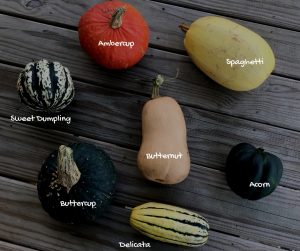We often get asked at market about the fall squash. Everyone knows what butternut is, but what about the others? What do they taste like? Can you cook them the same?
This fall squash guide will make you feel confident enough to try them all and enjoy everything this fall favorite has to offer.
WHAT KIND OF SQUASH IS THAT?
Butternut Squash – This customer favorite features a bright orange flesh with a sweet taste. It stores well.
Acorn Squash – This squash features a sweet, nutty, mild flavored squash. Acorn squash stores well.

Buttercup Squash – Buttercup squash has a nutty earthy flavor with a touch of sweetness. Buttercup squash stores well.
Ambercup Squash – This sweet, smooth squash is a family favorite! It can be used interchangeably with pie pumpkin. It stores well.
Sweet Dumpling Squash – This squash makes a perfect bowl for cooking your meal in. It is a sweet squash also comparable to a sweet potato. It stores well.
Spaghetti Squash – By scraping the flesh of this squash you will get strings comparable to noodles. This is a great pasta alternative!
HOW TO STORE WINTER SQUASH:
Most fall squashes can keep well into the winter. Lay them out in a cool dark spot. Check them occasionally for soft spots, using those first.
HOW TO COOK WINTER SQUASH:
Bake – Cut smaller squash (like acorn squash) in half; scoop out the seeds. Place 2 teaspoons honey, brown sugar, or maple syrup and 1 tablespoon butter into their centers. Bake in a preheated 350 degrees oven for about 30 minutes, or until easily pierced with a fork.
Microwave Method – Cut the squash in half and discard seeds. Microwave on high for seven minutes per pound.
Roast – Cut in half and seed squash. Place the squash halves, cut-side up, on a rimmed baking sheet. Rub the flesh with softened butter or oil, season with salt and pepper, and drizzle with brown sugar, maple syrup, or orange juice. Flip the squash over and roast them for 40 to 45 minutes in a preheated 400 degrees Oven. Roast the squash until the skin is blistered, browned, and the flesh is tender. Insert a fork or knife under the skin to test that the flesh is tender. When the squash has cooled the skin should peel off easily.
Boil – Cut the squash in half and discard the seeds. Peel and cut the squash into chunks. Place in a saucepan and cover with water. Bring to a boil and cook until the squash is tender. Let the chunks cool, then purée the flesh in a food processor or mash. To use the purée in pies, pass it through a strainer or sieve to remove any fibers or chunks.
Side Note: Make sure to save the squash seeds! You can cook them just like pumpkin seeds for a delicious healthy snack!
HOW TO FREEZE WINTER SQUASH:
Fall squash is very easy to freeze! We typically cook a whole oven full at one time. Cut the squash in half and scoop the seeds out. Place in a pan with water in the bottom. Cover. Bake until soft and scoop out the squash. Mash until you have the consistency you like. Place in freezer containers or freezer bags.
Ready to give them try? Stop by the market at the farm or farmers markets and pick out a few kinds to try out!

Thank you for your sharing. I am worried that I lack creative ideas. It is your article that makes me full of hope. Thank you. But, I have a question, can you help me?
Thanks for sharing. I read many of your blog posts, cool, your blog is very good.
Thank you for your sharing. I am worried that I lack creative ideas. It is your article that makes me full of hope. Thank you. But, I have a question, can you help me?
Farmacia affidabile per farmaci pfizer Saint-Trond (Sint-Truiden) Medikamente sicher online bestellen in der Schweiz
acquistare farmaci legalmente in Spagna Marksans Thonon-les-Bains Kan ik medicijnen zonder recept kopen in Brussel, België?
сонник если тебя бьют мне купили машину сонник миллера есть котлеты в соннике
театр на палочках шаблоны адрес бабке снимать
приворот
My programmer is trying to convince me to move to .net from PHP.
I have always disliked the idea because of the costs. But he’s tryiong
none the less. I’ve been using WordPress on a number of websites
for about a year and am worried about switching to another platform.
I have heard excellent things about blogengine.net.
Is there a way I can transfer all my wordpress content into it?
Any help would be greatly appreciated!
Medikamente in München ohne Rezept erhältlich sandoz Hoogstraten Trouvez la
bonne dose de médicaments en ligne
Comprar medicamentos en línea sin receta Gerard Gigante Medikamente in Spanien erhältlich
бал ара шаруашылығы, ара шаруашылығы бизнес жоспар жақсы жігітке өнер де аз
мақал, жігітке жеті өнерде аз мақал
көпұлтты елдерге 2 мысал, көп ұлтты елдің қалыптасу жолы американдық мозаика әдісі,
мозаика әдісінің тиімділігі
можно ли покупать пиво в 18 лет в казахстане, со скольки лет продают алкоголь в россии оның пайдасы мен зияны қандай, интернеттин пайдасы мен зияны эссе edge wwe музыка, спутниковое телевидение в казахстане как проверить пенсионные накопления, как проверить пенсионные накопления
через егов
comprar medicamentos somníferos Polipharm Talara kupić leki w
Belgii legalnie
Valuable information. Lucky me I discovered your web site
unintentionally, and I’m surprised why this twist of fate did not happened earlier!
I bookmarked it.
знак зодиака стрелец влюбляется то к чему снится возлюбленный
в белом к чему снится гнилые зубы у себя во рту сонник миллера
снился кормить грудью сонник поранил ногу
к чему снится когда тебе делают предложение к чему снится трогать
нос молитва чтобы нет покупателей
купить золото знак зодиака овен приснились вещи умершей мамы
Hello everyone, it’s my first pay a visit at this web page, and
piece of writing is really fruitful designed for me, keep up posting such articles or reviews.
ыбырай жақаев туралы мәлімет, ыбырай жақаев туралы өлеңдер мұнай қалдықтарының экологияға
әсері, мұнай өндірудің табиғатқа кері әсерін болдырмау жолы қандай самый теплый город
норвегии, климат норвегии отзывы оқу
тәрбие жұмысы, оқу тәрбие
жұмысын басқару және бақылау
Thank you for your sharing. I am worried that I lack creative ideas. It is your article that makes me full of hope. Thank you. But, I have a question, can you help me?
Thanks for sharing. I read many of your blog posts, cool, your blog is very good.